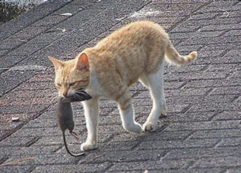Community Cat Program
The biggest challenge most animal control program's face is reducing feral cat populations.
Communities use one of three methods to deal with feral cats. 1) Do nothing, 2) Eradication, or 3) Trap/Neuter/Return.
It’s easy to understand why doing nothing doesn’t reduce feral cat populations. But it's harder to understand why eradication doesn't work.
There are two biological reasons why “catch and kill” fails.
The stress of removing cats from their colony triggers two survival mechanisms. 1) They will now over breed, and 2) over produce.
Trap/Neuter
That is, instead of one litter a year of three kittens, a stressed cat will have three litters of nine kittens.
Even if we could remove all the feral cats in a neighborhood, that would create a "vacuum effect" -meaning the cats from surrounding neighborhoods will fill the ecological niche left behind because the deterrent of territorial cats was removed.
The vacated neighborhood is soon overrun with new cats fighting for mates, over breeding, and marking their new territory as their own.
This is why the City of Dickinson promotes Trap/Neuter/Return (TNR).
Bayou Animal Services permits individuals, or organizations, to practice TNR. Trapped cats are neutered, vaccinated against rabies, and ear tipped. The ear tip identifies the cat as part of a managed colony. These cats are returned to their neighborhood under the care of a Colony Manager responsible to feed, water, and care for them.
TNR prevents the vacuum effect while reducing the troubling behaviors intact cats display, such as fighting, caterwauling, and spraying for territory.
And Return
The returned cats provide rodent abatement and eliminate the need for toxic poisons that put our pets, children, and wildlife at risk. This is a benefit many neighborhoods would sorely miss if the cats were permanently removed.
Feral cats only live 3-5 years, so all the problems associated with feral cats are resolved through attrition.
TNR also solves public nuisance complaints in public spaces. Altered cats no longer have the urge to breed and prey, so you can train them to follow the food bowl and congregate out of the way of the public.
TNR even satisfies the concerns of environmental groups because as TNR reduces feral cat populations, the threat to songbirds and wildlife is also reduced. TNR is a win/win for all!


